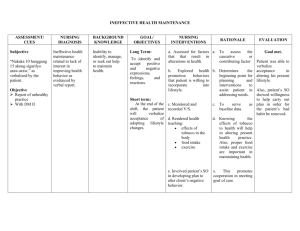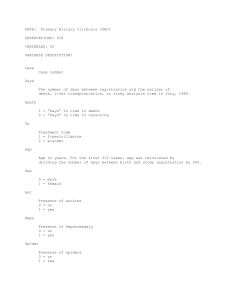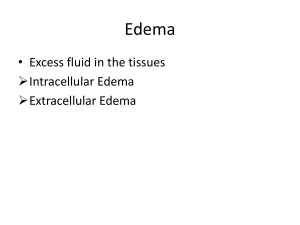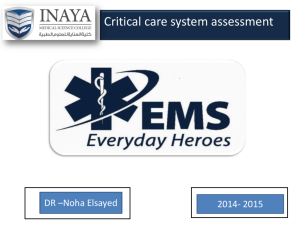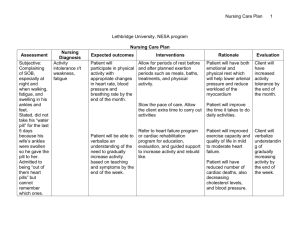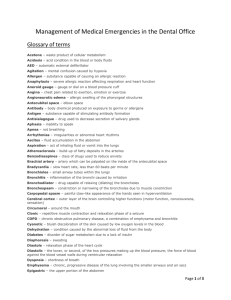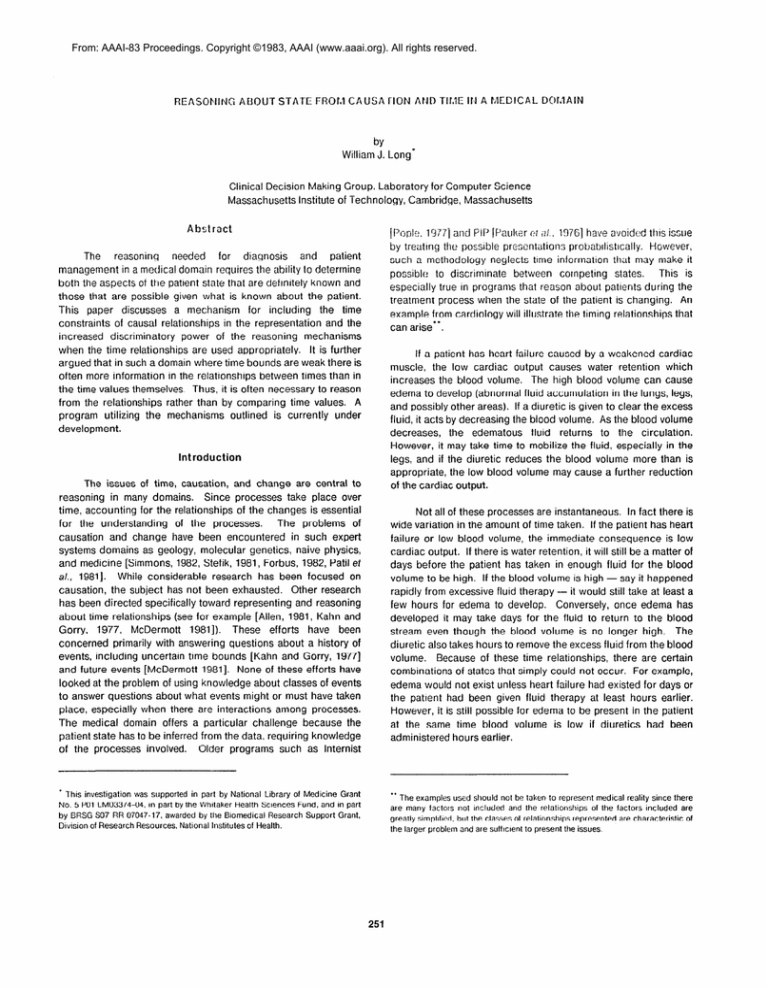
From: AAAI-83 Proceedings. Copyright ©1983, AAAI (www.aaai.org). All rights reserved.
by
William J. Long*
Clinical Decision Making Group. Laboratory for Computer Science
Massachusetts Institute of Technology, Cambridge, Massachusetts
Abstract
[Ponle. 13771 and Fli’ [Pauker FI ;I/ . 197G] have avoided this issue
by treating the possible presentations probabilistically.
HGWeVer,
such a methodology neglects time information that may make it
This is
possible to discriminate
between competing states.
especially true m programs that reason about patients during the
treatment process when the state of the patient is changing.
An
example from cardiology will illustrate the timmg relationships that
can arise**.
The
reasoning
and
patient
needed
for
diagnosis
management in a medical domain requires the ability to determine
both the aspects of ttle patient state that are definitely known and
those that are possible given what is known about the patient.
This paper discusses a mechanism
for including
the time
constraints of causal relationships in the representation and the
increased discriminatory
power of the reasoning mechanisms
when the time relationships are used appropriately.
It is further
argued that in such a domain where time bounds are weak there is
often more information in the relationships between times than in
the time values themselves. Thus, it is often necessary to reason
from the relationships rather than by comparing time values. A
program utilizing the mechanisms outlined is currently under
development.
If a patient has heart failure caused by a weakened cardiac
muscle, the low cardiac output causes water retention which
increases the blood volume. The high blood volume can cause
edema to develop (abnormal fluid accumulation in the lungs, legs,
and possibly other areas). If a diuretic is given to clear the excess
fluid, it acts by decreasing the blood volume. As the blood volume
decreases,
the edematous
fluid returns to the circulation.
However, it may take time to mobilize the fluid, especially in the
legs, and if the diuretic reduces the blood volume more than is
appropriate, the low blood volume may cause a further reduction
of the cardiac output.
Introduction
The issues of time, causation, and change are central to
reasoning in many domains.
Since processes take place over
time, accounting for the relationships of the changes is essential
The problems of
for the understanding
of the processes.
causation and change have been encountered
in such expert
systems domains as geology, molecular genetics, naive physics,
and medicine [Simmons, 1982, Stefik, 1981, Forbus, 1982, Patil ef
al., 19811. While considerable research has been focused on
Not all of these processes are instantaneous.
In fact there is
wide variation in the amount of time taken. If the patient has heat-t
failure or low blood volume, the immediate consequence
is low
cardiac output. If there is water retention, it will still be a matter of
days before the patient has taken in enough fluid for the blood
volume to be high. If the blood volume is high - say it happened
rapidly from excessive fluid therapy - it would still take at least a
few hours for edema to develop.
Conversely, once edema has
developed it may take days for the fluid to return to the blood
stream even though the blood volume is no longer high. The
diuretic also takes hours to remove the excess fluid from the blood
volume.
Because of these time relationships, there are certain
combinations of states that simply could not occur. For example,
edema would not exist unless heart failure had existed for days or
the pattent had been given fluid therapy at least hours earlier.
However, it is still possible for edema to be present in the patient
at the same time blood volume is low if diuretics had been
administered hours earlier.
causation, the subject has not been exhausted.
Other research
has been directed specifically toward representing and reasoning
about time relationships (see for example [Allen, 1981, Kahn and
Gorry, 1977, McDermott
19811). These efforts have been
concerned primarily with answering questions about a history of
events, including uncertain time bounds [Kahn and Gorry, 19771
and future events [McDermott 19811. None of these efforts have
looked at the problem of using knowledge about classes of events
to answer questions about what events might or must have taken
place, especially when there are interactions among processes.
The medical domain offers a particular challenge because the
patient state has to be inferred from the data, requiring knowledge
Older programs such as Internist
of the processes involved.
’ 1 hts investigation
was supported
No. 5 PO1 LM03374-04.
by BRSG SO7 RR 07047-17,
Dlvislon of Research
in part by National
in part by the Whrtaker Health
awarded
Resources,
by the Biomedical
NatIonal
lnstltutes
Library
Sciences
of Medicine
Grant
** The examples
Fund, and in part
Research
Support
Grant,
of Health.
used should not be taken to represent
are many factors
not Included
and the relationships
greatly simpllflcd,
but the classes of relabonshlps
the larger problem and are suffloent
251
medical
reality since there
of the factors
represented
to present the issues.
included
are characteristic
are
of
Representation
of State,
of causes or correctrons
The causer, and corrections
can further be drvrdcd into those that make the state possible and
those that will definitely result in the state.
This yields the
following template for representing the causes of a state:
Time, and Causation
:\lil,t?llCFf
The appropriate representation
for a problem depends on
the kinds of reasoning to be done and the characteristics of the
domain. The reasoning we are concerned with is found in both
diagnosis and patient management - we need to determine what
is known about the patient state from the available information,
including what is definite and what is uncertain but possible. It is
also useful to assign likelihood measures to possible conclusions,
but that is beyond the scope of this paper - the determination of
possible and definite in this paper can be viewed as a controlled
framework in which a likelihood mechanism could operate.
P+
D+
PDrelax
: causal conditions that make the state possible
: causal conditions that make the state definite
: corrective conditions that possibly stop the state
: corrective conditions that definitely stop the state
: time range for the state to end after the cause ends
The causes for high blood volume within the simplified domain are
represented
In medicine the meanings of measurements of the patient
state tend to vary from patient to patient. While “normal” ranges
P+
D+
PDrelax
are identified for many parameters, they are only confidence
The important determination is the
intervals for the population.
That is, a parameter
is
relationship
between parameters.
abnormal because it has an effect on something else. Physicians
tend to express this by using qualitative measures for parameter
as follows:
retain water (tl), fluid therapy (0)
retain water (t2)
no fluid therapy and lose water (t3)
no fluid therapy and lose water (t4)
(t5 t6) ; minimum and maximum relaxation
times
Retaining water for at least time tl could cause high blood volume
as could fluid therapy for any amount of time. Retaining water for
time t2 would definitely cause high blood volume. If the patient
stops retaining water and does not receive fluid therapy, the blood
volume could return to normal possibly by time t5 and certainly will
by t6. Actively losing water will hasten this process, restoring
normal blood volume possibly by time t3 and certainly will by t4.
This representation of cause extends the notion of continuous
causalion
and thresholds
to include the temporal relationships
between cause and effect [Reiger and Grinberg, 19771. The
resulting representation is sufficient to represent the properties
needed for answering questions about the patient state.
values (e.g., low cardiac output) even when quantitative measures
are available.
Thus, we have chosen to represent parameter
states qualitatively
with the values defined in terms of other
parameters.
For example, blood volume may be low, normal, or
high. A low blood volume is a blood volume that will result in low
cardiac output, whatever the value might be for an individual
patient. Defining the qualitative values in this way means that it is
usually not possible to associate exact numbers with the values there are no universally valid “boiling points” as in physical
This places more burden on the
systems [Forbus, 19821.
interpretation
of patient
measurements,
but simplifies
the
reasoning problem.
Many rules about causation are general.
For example, all
abnormal states have causes; the effect depends on the sum of
the influences; and causes must start prior to or simultaneously
with the effect.
In this domain there are additional properties
useful as rules for reasoning:
1) The cause and the effect must
overlap, i.e., the cause can not end before the effect starts. 2) The
state changes must be from the adjacent states, e.g., for retaining
water to cause high blood volume the blood volume must be
normal already.
Since the causes usually also correct the
opposing abnormal state, this is useful to keep the time bounds
more precise where possible. 3) Causation once started continues
until there is some change either in the cause or the corrective
influences.
Thus, if high blood volume were causing edema, it
would continue to cause edema until the cause were changed,
even though high blood volume does not necessarily cause
edema (in this model). (In the actual domain it is also necessary to
represent
precipitating
factors
factors that can mean the
difference between causing and not causing the effect, but are
incapable of causing the effect themselves. The extension follows
without difficulty.)
Similarly, time relations in medicine tend to be inexact. For
example, there is no exact time when low cardiac output started.
Although one can say it has been present for days but not weeks,
more precision is impossible.
Expressing the templates for
causality also requires that the range of possible time delays
between cause and effect be represented.
The bounds of these
ranges are likewise difficult to express in exact terms it takes
from hours to days to mobilize edema.
Rather than require
artificially exact bounds to be specified, we use qualitative fimes
related by a partial ordering. Thus the time bounds of a relation
can be viewed as a qualitatively specified confidence interval.
Causation in the medical domain has other characteristics.
1) The factors influencing a particular parameter are limited and
each can be suitably represented.
Thus, it is appropriate to
reason in terms of a closed domain of possible influences. 2)
Some of the cause-effect relations are only probabilistic at the
present state of medical knowledge. These will be represented as
possible, without dealing with the likelihood. 3) The domain is also
dominated
by stable feedback systems.
As a result, it is
computationally
more reasonable to accept the tendency of the
systems to return to stable states as given and only represent the
influences on the abnormal states,
An Example
The causal relationships for the example are sketched in
figure 1 (without the corrections or time relations). Given the
corresponding
relationships represented by the formalism, the
program is able to determine what is definitely known about the
patient by propagating the minimum conclusions from the causal
relationships.
If the patient presently has edema and has not had
Thus, the representation
of potential
influences
on an
abnormal parameter value include the possible causes for the
value with the time relationships between cause and effect, the
possible corrections for the value with those time relations, and
the time requirements for the parameter to return to normal in the
252
possible cause
Gl
definite cause
possible correction (not all shown)
9
past
8
7
6
5
4
0
321
now
future
Figure 3. Edema and Low Blood Volume
Figure 1. Example Causal Relations
water retention *
txcscnt
low cardiac output
cdcma
The other causes have no delay and are therefore
with the water retention.
low cardiac output *
present
/ weak heart
\
10
past
*
7
6
5 4
321
0
now
heart failure V low blood volume
However, low blood volume is not consistent
with the normal and
high blood volume that must overlap the required time period.
/
9
simultaneous
heart failure *
fixure
weak heart
The relaxation time for a weak heart is infinite.
Thus while the
weak heart is deduced true from t7 to t10 to account for the heart
failure, once it exists it must remain.
Figure 2. Edema without Fluid Therapy
by the
If we assume that nothing is known about therapy in the
patient other than the lack of fluid therapy, then nothing more can
be concluded.
The result of this deduction is a representation of
the set of facts that must hold given the edema.
High blood volume is the only available cause. It must exist or
have existed to account for the edema present. The time from 0 to
6 (to-6) in the figure is the maximum relaxation time for the edema.
That is, the high blood volume had to be true at least that recently
or the edema would definitely have disappeared by now. The
difference between times 8 and 9 (t8-9) is the minimum time for
which high blood volume must persist to cause edema. It is not
specified when the edema started, but the high blood volume must
have started at least that long before the start of the edema.
The example has been extended in figure 3 to show that it is
possible for the patient to have low blood volume even though
edema is present. If we assume the patient has not received
digitalis (which could correct the heart failure), the heart failure
and low cardiac output must have continued
until time now
because the cause has not changed.
fluid therapy, the conclusions (somewhat overconstrained
diagram) are illustrated in figure 2 and deduced as follows:
edema *
high blood volume
high blood volume A fluid therapy: not given *
low blood volume =
water loss
The patient must have been losing water at least until time tl ago,
having started losing water and having had a normal blood volume
at least t3-4 prior.
water retention
The water retention must not have ended more than t6-7 prior to
the end of the high blood volume and must have started at least
t9-10 prior to the beginning of the high blood volume. Since to
cause high blood volume the blood volume must be normal at
least for a time, normal blood volume must exist at least t9-10 prior
to the high blood volume. (Normal blood volume and retaining
water do not have to start at the same time. They just have the
same minimal time relationship to high blood volume.)
water loss * diuretic effect
diuretic effect * diuretic
The program can determine a specific time interval during which
diuretic therapy would have to have been given for there to be low
blood volume now. The more common deduction of the possible
effects from known times of therapy could also be made.
253
For the low blood volume to be consistent
with the edema,
the end of the high blood volume must be before the start of
normal blood volume (and likewise for water retention and loss).
Therefore since the maximum time for the edema to be removed is
longer than the minimum time that water loss takes to cause low
blood volume, it is possible for both to exist simultaneously.
References
PI
Science
Finally, let us consider a little more deeply the reasoning that
eliminated low blood volume as a cause of the low cardiac output.
All that is known about the time of the high blood volume is that it
must have begun at least t8-9 (say hours) ago but could have
begun and ended to-6 (say days) ago. Similarly, the cause of the
low cardiac output began at least t8-9 + t9-10 (hours) ago but
could have begun and ended to-6 + t6-7 (days) ago.
It is
impossible to conclude that the low blood volume is incompatible
with the high blood volume by comparing these ranges.
The
important information is the temporal relationship between cause
and effect. The cause for the low cardiac output must continue
Forbus, K. D., “Qualitative
664, February 1982.
PI
Kahn, K. and Gorry, G. A., “Mechanizing
Temporal
Knowledge,” Artificial lnfelligence
9, (1977) 87-108.
PI
Long, W., Naimi, S.. and Criscitiello, M. G., “A Knowledge
Representation
for Reasoning about the Management
of
Heart Failure,”
Computers
in
Cardiology
Conference,
October 1982.
Fl
McDermott, D., “A Temporal Logic for Reasoning About
Department
of
Processes and Plans,” Yale University
Computer
Science Research
Report 196, March 1981.
PI
Patil, R. S., Szolovits, P., and Schwartz, W. B., “Causal
Understanding
of Patient Illness in Medical Diagnosis,”
Proceedings
of IJCAI-7, August 1981, pp. 893-899.
171
Pauker, S. G., Gorry, G. A., Kassirer, J. P., and Schwartz, W.
B., “Toward the Simulation of Clinical Cognition: Taking a
Present Illness by Computer,” The American
Journal
of
Medicine
60, (1976) 981-995.
Diagnostic
Problem
Solving:
Reasoning,”
Proceedings
of
1030-1037.
Thus, any representation
of the times of these states must
preserve both the constraints on the times and the relationships
tomakeall of the reasoning possible.
M/T A/-Memo
an
Exercise
in Synthetic
August 1977, pp.
IJCAI-5,
191
“The
Declarative
Reiger,
C.
and
Grinberg,
M.,
Representation
and Procedural Simulation of Causality in
Physical Mechanisms,”
Proceedings
of IJCAI-5,
August
1977, pp. 250-256.
[lo]
Summons, R. G., “Spatial
and Temporal
Proceedings
Geologic Map Interpretation,”
August 1982, pp. 152-154.
Acknowledgements
The work reported here is part of the development
of a
program to assist the physician in the diagnosis and management
of heart failure [Long et al., 19821. The ideas are presented as
separate from that work, but the results will become a part of that
work as it progresses.
For an understanding
of some of the
problems and issues confronting
the physician,
I thank our
collaborators on that project, Drs. Criscitiello, Naimi, and Pauker
of New England Medical Center Hospital.
Process Theory,”
I?31Pople, H. E., Jr., “The Formation of Composite Hypotheses in
until the low cardiac output ends, which is when the retaining of
water ends, which is necessarily after the blood volume is high.
between the states
F., “Maintaining
Knowledge
about Temporal
Deparfment
of Computer
University of Rochester
TR 86, January 1981.
PI
Discussion
There are three observations
to be made about the
deductions facilitated by the mechanisms presented.
First, the
mechanisms
are capable
of discrimination
that would be
impossible without the use of the time relationships. The ability to
filter out the impossible from among the possible contingencies
allows a program to have more focused reasoning about the
legitimate
possibilities.
Second,
the mechanisms
permit
reasoning both about the definite and the possible.
Thus, the
same mechanism is useful for determining what is known about
the patient state and deducing the possible effects of therapy.
Allen, J.
Intervals,”
[l l] Stefik, M., “Planning
Artificial
lnfelligence
with Constraints
76, (1981) 11 l-140.
Reasoning
of
(MOLGEN:
in
AAAI-82,
Part I),”

